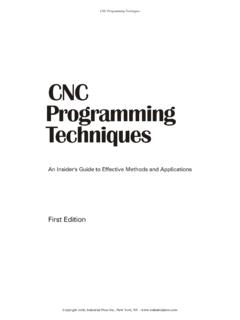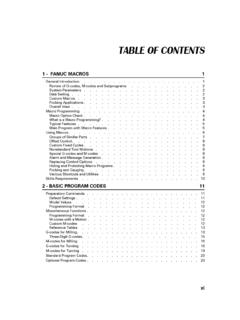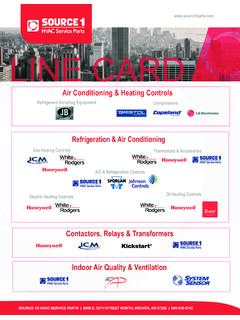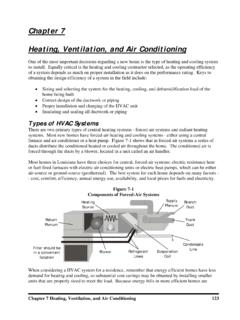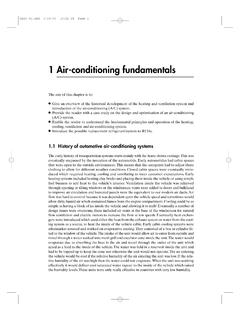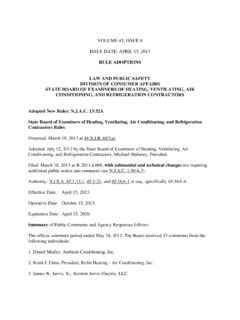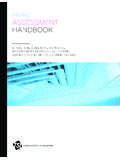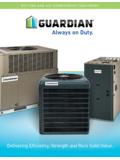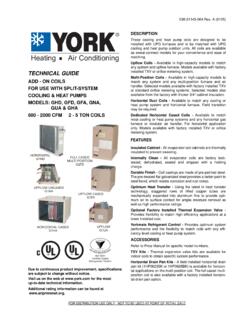Transcription of HVAC: Handbook of Heating, Ventilation and Air …
1 THIS Handbook PROVIDES COMPREHENSIVE TECHNICAL INFORMATION TO Heating, VENTILATING, AND air conditioning ENGINEERS, DESIGNERS AND PRACTITIONERSHVAC: Handbook of Heating, Ventilation andAir conditioning forDesign and ImplementationBYALI VEDAVARZ, , PEDeputy Director of Engineering, New York City Capital Projects, New York City Housing Authority andIndustry Professor, Polytechnic University, Brooklyn, NY SUNIL KUMAR, of Mechanical Engineering and Dean of Graduate SchoolPolytechnic University, Brooklyn, NYMUHAMMED IQBAL HUSSAIN, PEMechanical Engineer, Department of Citywide Administrative ServicesNew York City, NY2007 INDUSTRIAL PRESS YORKHVAC: Handbook of heating , Ventilation and Air ConditioningCopyright 2007, Industrial Press Inc., New York, NY - 2007 by Industrial Press Inc., New York, of Congress Cataloging-in-Publication Data Vedavarz, : Handbook of heating Ventilation and air conditioning / Ali Vedavarz, Sunil Kumar, MuhammedHussain. p. 0-8311-3163-2 ISBN13 978-0-8311-3163-0I.
2 heating --Handbooks, manuals, etc. 2. Ventilation --Handbooks, manuals, etc. 3. air conditioning --Handbooks, manuals, etc. 4. Buildings--Environmental engineering--Handbooks, manuals, etc. I. Kumar, Hussain, Muhammed Iqbal. III. and bound in the United States of America All rights reserved. This book or parts thereof may not be reproduced, stored in a retrieval system,or transmitted in any form without permission of the 2006697--dc222006041837 Cover Photo: Image published with kind permission of CVRD and Bluhm PRESS, Avenue of the AmericasNew York, New York 10018 -54101st Edition First Printing10987654321 hvac : Handbook of heating , Ventilation and Air ConditioningCopyright 2007, Industrial Press Inc., New York, NY - OF 1 Fundamentals of Thermodynamics1 3 Conservation of Mass1 3 First Law of Thermodynamics1 4 Second Law, Reversibility, and Possible Processes1 4 Thermodynamic Cycles1 6 Fundamentals of Fluid Flow1 6 Flow in Pipes and Ducts1 11 Noise from Fluid Flow1 11 Fundamentals of Heat Transfer1 14 Overall Heat Transfer1 15 Fins and Extended Surfaces1 18 Some Details of Heat Exchange1 19 Augmentation of Heat 1 Psychrometrics2 1 Ideal Gas Approximation2 1 Equation of State2 2 Humidity Ratio2 2 Relative Humidity 2 2 Degree of Saturation2 2 Wet Bulb Temperature2 3 Partial Pressure of Water Vapor2 4 Dew Point Temperature2 4 Saturation2 4 Enthalpy2 5 Wet Bulb Temperature2 6 Properties of Moist Air2 7 Psychrometric Chart Presentation2 12 Thermodynamic Properties of Water at Saturation2 18 Thermodynamic Properties of Moist conditioning PROCESSES3 1 Introduction3 1 heating and Cooling Process3 2 Cooling with Dehumidification3 3 heating with Humidification3 3 Adiabatic Mixing of Two Air Streams3 5 Evaporative Cooling3 5 heating and air conditioning System AIR QUALITY AND VENTILATION4 1 Indoor Air Quality4 1
3 Ventilation Procedure4 5 Concentration of Air Pollutants4 6 Indoor Air Quality Procedure4 8 Filters4 10 Hepa Filters4 10 Carbon Media Filters4 10 Fiber and Foam Filters4 10 Ozone4 10 Ultraviolet ESTIMATING FUNDAMENTALS5 1 Conduction5 1 Thermal Conductivities of Materials5 2 Convection5 4 Thermal Radiation5 4 Emissivities of Some Materials5 6 Overall Heat Transfer Coefficient5 8 Parallel Arrangement5 11 Coefficient of Transmission (Continued) ESTIMATING FUNDAMENTALS5 17 Relative Thermal Resistances of Building Materials5 18 Surface Conductances and Resistances5 18 Emittance Values of Various Surafces5 19 Thermal Resistances of Plane Airspaces5 21 Thermal Properties of Building and Insulating Materials5 27 Coefficients of Heat Transmission of Various Fenestrations5 28 Transmission Coefficients for Wood and Steel Doors5 29 Outdoor Air Load LOAD CALCULATIONS6 1 Introduction 6 1 Calculating Design heating Loads6 2 Heat loss Through Walls, Roofs, and Glass Area6 2 Heat Loss from Walls below Grade6 3 Below-Grade Wall U-Factors6 3 Heat Loss from Basement Floor Below Grade6 4 Heat Loss Coefficients 6 4 Heat Loss from Floor Slab On Grade6 6 Ventilation and Infiltration Heat LOAD CALCULATIONS7 1 Transfer Function Method (TFM)
4 7 1 Heat Source in Conditioned Space7 2 Heat Gain from Occupants7 3 Heat Gain from Cooking Appliances7 6 Heat Gain from Medical Equipments7 6 Heat Gain from Computer 7 6 Heat Gain from Office Equipments7 6 CLTD/SCL/CLF Calculation Procedure7 7 Cooling Load by CLTD/SCL/CLF Method7 8 Roof Numbers7 9 CLTD for Roofs7 11 CLTD for Walls7 27 Code Number for Wall and Roof7 28 Wall Types7 31 CLTD for Glass7 31 Zone Types for CLF Tables7 31 Zone Types for SCL and CLF Tables7 35 Residential Cooling Load Procedure7 36 SCL for Glass7 44 CLF for People and Unhooded Equipments7 46 CLF for Hooded Equipments7 47 Window GLF for Residences7 49 CLTD for Residences7 50SC for Windows7 50 SLF for Windows7 50 Air Exchange DESIGN8 1 Introduction8 1 Pressure Head and Energy Equation8 2 Friction Loss Analysis8 7 Dynamic Losses8 7 Ductwork Sectional Losses8 8 Fan System Interface8 8 Pressure Changes System8 9 Duct System Design8 9 Design Considerations8 12 Duct Design Methods8 13 Duct Design Procedures8 13 Automated Duct Design8 14 Duct Fitting Friction Loss Example8 14 Equal Friction Method Example8 15 Resistance in Low Pressure Duct System Example8 15 Static Regain Method Example8 17 Fitting Loss CoefficientsHVAC: Handbook of heating , Ventilation and Air ConditioningCopyright 2007, Industrial Press Inc.
5 , New York, NY - OF SIZING9 1 Pressure Drop Equations9 1 Valve and Fitting Losses9 3 Water Piping9 3 Flow Rate Limitations9 3 Noise Generation9 3 Erosion9 3 Allowances for Aging9 4 Water Hammer9 4 Hydronic System Piping9 6 Valve and Fitting Pressure Drop9 28 Service Water Piping9 29 Plastic Pipe9 29 Cold Water Pipe Sizing9 31 Steam Flow in Pipes9 31 Steam Flow Formulas9 32 Vertical Pipes9 32 Steam Piping9 59 Gas Piping For Buildings9 59 Residential Piping9 61 Commercial-Industrial Piping9 72 Compressed Air Systems9 72 Compressed Air9 78 Viscosity of Liquids9 80 Piping9 80 Types of Materials9 91 Plastics Pipe9 91 Joining Techniques9 93 Standards for Specification and Identification9 93 Design Parameters9 96 Installation9 97 Codes and Regulations9 97 Pipe Fittings9 97 Taper Pipe Thread9 132 Laying Lengths of Pipe with Screwed Fittings9 134 Allowable Spaces for Pipes9 134 Expansion of Pipe9 136 Corrosion Resistance9 136 Pipe Support Spacing9 139 Gate, Globe, and Check Valves9 139 Operation9 141 Maintenance Methods9 142 Formulas for Sizing Control Valves9 142To Determine Valve Size9 142To Determine Valve Capacity9 142 For Vapors Other Than Steam9 143 Identification of Piping Systems9 143 Dangerous Materials9 143 Fire Protection Materials and Equipment9 144 Safe Materials9 144 Protective Materials9 144 Method of Identification9 144 Heat Losses in Piping9 144 Heat Losses from Bare Pipe9 145 Heat Losses from Steam Piping9 157 Heat Loss from Insulated Pipe9 158 Cold Surface heating AND COOLING SYSTEM10 1 Basic System10 4 Temperature Classifications10 4 Closed Hydronic System Components Design10 4 Convectors or Terminal Units10 4 Boiler10 4 Air Eliminations Methods10 6 Pressure Increase Due to Change in Temperature10 6 Expansion Tank10 7 Expansion Tank Sizing(Continued)
6 heating AND COOLING SYSTEM10 8 Characteristics of Centrifugal Pumps10 8 Operating Characteristics10 9 Pump Laws10 9 Change of Performance10 10 Centrifugal Pump Selection10 10 Total Dynamic Head10 11 Net Positive Suction Head (NPSH)10 11 Pumping System10 16 Parallel Pumping10 17 Series Pumping10 18 Design Procedures10 18 Preliminary Equipment Layout10 19 Final Pipe Sizing and Pressure Drop Determination10 19 Final Pressure Drop10 19 Final Pump Selection10 19 Freeze CALCULATION11 1 Degree Day11 165 F as the Base11 2 Application of Degree Days11 4 Predicting Fuel Consumption11 5 Predicting Future Needs11 7 Empirical Constants11 7 Load Factor and Operating Hours11 7 Limitations11 8 Degree-Days Abroad11 9 Degree Days for Various US 1 Combustion Basics12 3 Efficiency Calculations12 7 Saving Fuel with Combustion Controls12 11 Combustion Considerations12 11 Pressure and Flow Basic Principles12 12 Atomizing Media Considerations12 12 Combustion Air Considerations12 13 Flue Gas Considerations12 14 Gas Fuel Firing Considerations12 14 Fuel Oil Firing Considerations12 15 Operational Rules of Thumb12 16 Common Application12 20 Combustion Control Strategies12 20 Control System Errors12 20 Combustion Control
7 Strategies12 21 Parallel Positioning Systems12 22 Fully Metered Control12 23 Feedwater Control Systems12 24 Draft Control12 26 Oxygen Trim12 27 Combustion Air Flow Control Techniques12 28 Flue Gas Recirculation (FGR)12 33 Fuel Oil Handling System Design12 33 Determination of Required Flow Rate12 34 Stand by Generator Loop Systems12 34 Multiple Pumps12 34 Burner Loop Systems12 36 Maximum Inlet Suction12 37 Pump Discharge Pressure12 37 Piping System Design12 37 Pump Set Control System StrategiesHVAC: Handbook of heating , Ventilation and Air ConditioningCopyright 2007, Industrial Press Inc., New York, NY - OF conditioning SYSTEMS13 1 air conditioning Systems13 1 Single Package Units13 5 Single Package Installations13 7 Installation of Split Systems13 8 Zoning Unitary Installations13 10 Selection Procedure13 14 Evaporative Air Conditioning13 14 Permissible Air Motion13 17 Variable Volume AC System13 18 Initial Costs13 20 Cooling Considerations13 21 Overlapping13 22 Heat Recovery13 22 heating Cooling Systems13 23 Air Systems13 26 Controls13 27 Air Water Systems13 30 Sources of Internal Heat13 31 Heat from Service Refrigeration13 31 Exhaust Air Heat Recovery Systems13 36 Heat Pumps13 36 Reverse-Cycle Principle13 36 Coefficient of Performance13 37 heating Season Performance Factor13 37 Types of Heat Pumps13 38 Air-to-Air Heat Pumps13 39 Water-to-Water Heat Pumps13 40 Water-to-Air Heat Pumps13 40 Air-to-Water Heat Pumps13 41 Ground Source Heat Pumps13 41 Special Heat Sources13 42 Operating and Installation Factors13 42 Outdoor Temperature Effects13 43 Thermostats13 43
8 Heat Anticipators13 44 Equipment Arrangement13 44 Electrohydronic Heat Recovery13 45 Cooling Cycle13 47 System Design13 47 Supplementary Heat13 47 Optimized Data for Heat Pump13 48 Development of Equations13 48 Development of Tables13 49 Selecting Air Handling Units13 54 Well Water Air Conditioning13 54 Heat Pump/Solar Energy Application13 54 System Description and Operation13 60 High Velocity Dual Duct Systems13 60 Advantages and Disadvantages13 60 Dual Duct Cycles13 65 Duct Sizing Technique13 65 Large vs. Small Ducts13 66 Design Velocity13 66 Maximum Velocity13 67 Sizing High Pressure Ducts13 68 Return Air Ducts13 68 Low Pressure Ductwork13 69 Basic Arrangement13 69 Zoning13 70 Ceiling Plenum13 73 Modular Type Office Buildings13 76 Constant Volume Mixing Units13 77 Apparatus Floor Area13 80 Construction Details13 81 Automatic Control Applications13 81 Rooftop Multizone Units13 84 Multizone Unit Control13 88 Damper Control13 88 Economizer Control Cycle13 88 Unit Ventilator Control(Continued)
9 conditioning SYSTEMS13 91 Hot Water System Control13 94 Mixing Box Control13 95 Rotary Air-to-Air Heat Exchanger Control13 95 Automatic Control for Dual Duct System13 97 Winterizing Chilled Water System13 97 Water Circulation to Prevent Freeze-Up13 99 Mechanical Draft Cooling Towers13 102 Atmospheric Cooling Towers13 104 Quantity of Cooling Water Required13 105 Roof is a Location for AC Equipment13 105 Advantages of Roof13 106 Disadvantages of Roof13 107 Servicing Cooling Plant13 107 Servicing Cooling Plant for Summer Use13 107 Water System13 107 Air Handling System13 107 Compressor Oil13 107 Condenser13 108 Refrigeration Unit13 108 Check Oil13 108 Compressor 13 108 air conditioning Equipment Maintenance13 108 Air Handling Equipment13 108 Air Distribution Equipment13 108 Water-Using Equipment13 108 Cooling Equipment13 110 air conditioning Maintenance Schedule13 111 Unit Air Conditioners13 111 Central Systems13 111 Condensing Water Circuit13 112 Cooling Water System13 112 Filters and Ducts13 112 air conditioning Maintenance Procedure13 112 Refrigerant Circuit and Controls13 113 Condensing Water Circuit13 113 Cooling Water System13 113 Filters and Ducts13 114 Rotating Apparatus13 114 Unit Air Conditioners13 114 Checklist for air conditioning HANDLING AND VENTILATION14 1 Terminology, Abbreviations.
10 And Definitions14 3 Fan Laws14 11 Fan Performance Curves14 16 Class Limits for Fans14 21 Fan Selection14 26 Fan Inlet Connections14 27 Fan Discharge Conditions14 31 Useful Fan Formulas14 32 Nomographs for Fan Horsepower14 32 Monographs for Fan Horsepower and Actual Capacity14 34 Fan Selection Questionnaire14 37 Air Flow in Ducts14 40 Pitot Traverse14 40 Friction Losses14 40 Correction for Roughness14 40 Rectangular Duct14 52 Air Balancing and Air Turning Hardware14 56 Air Distribution14 56 Fire Dampers and Fire Protection14 56 Duct System Design14 59 High Velocity System Design14 68 Step by Step Design14 68 Main Duct14 70 Branch Trunk Ducts14 71 Single Branch Lines14 72 Duct Design by Computer14 73 Fibrous Glass Duct ConstructionHVAC: Handbook of heating , Ventilation and Air ConditioningCopyright 2007, Industrial Press Inc., New York, NY - OF CONTENTSvi(Continued) HANDLING AND VENTILATION14 75 Determining Required Air Volume14 75 Estimating Weight of Metal 14 77 Apparatus Casing Construction14 77 Condensate Drains for air conditioning Units14 78 Air Filters and Dust Collectors14 78 Air Filters14 79 Dust Collectors14 82 Dry Centrifugal Collectors14 82 Wet Collectors14 82 Fabric Collectors14 83 Electrostatic Precipitators14 83 Breeching Design and Construction14 83 Expansion14 84 Aerodynamics14 85 Access14 85 Round Breeching Construction14 85 Rectangular Breeching Construction14 90 Chimney Draft and Velocities14 92 Forced Draft and Draft Control14 94 Sizing of Large Chimneys14 95 Chimney Design and Construction14 96 Balancing Small air conditioning Systems14 97 Balancing Medium and Large Systems14 98 Balancing Duct Distribution14 98 Balancing Systems Using Booster Fans14 99 Air Balancing by Balancing and Testing heating SYSTEM DESIGN15 1 Large Systems15 1 Equivalent Direct Radiation15 1 Piping Connections to Boilers15 3 Direct Return
